In June 2025, Purple Martins, one of the largest species of swallows, appeared in Stockbridge, MA, marking the first confirmed breeding record for the birds in the Berkshires in 130 years. This is part of a huge conservation success story of the collaborative efforts in the northwest corner of Connecticut between the Marvelwood School, the Kent Land Trust, the Purple Martin Conservation Association, Sharon Audubon Center, the Jeniam Foundation, and the Connecticut Department of Energy and Environmental Protection. These efforts have restored and expanded inland Purple Martin breeding populations in Connecticut. In New England, according to the Breeding Bird Survey and the PMCA, CT and MA are the only states with positive population growth for this species in the region. While populations in MA have stagnated a bit in the last few years, population growth in CT continues to increase.
One of the Purple Martins found breeding in Stockbridge, MA was color banded and confirmed to be a bird banded two years ago by my interview guests at The Emily Winthrop Miles Wildlife Audubon Sanctuary in Sharon, CT.
Laurie Doss and Ashley Wilkins are two of the key individuals involved in this work. Laurie is the science department chair at Marvelwood School and sits on the boards of directors for the Kent Land Trust and the Purple Martin Conservation Association. Ashley is a Kent Land Trust intern, a former Marvelwood student, and a University of Rhode Island sophomore studying animal science. They discuss the unique relationship between humans and Purple Martins, the birds' current status, community partnerships and the inter-generational commitment to martin conservation fostered by this work. They also share ways we can help Purple Martins in the Hudson Valley and surrounding areas.
It is important to note that all banding, marking, and sampling is being conducted under a federally authorized Bird Banding Permit issued by the U.S. Geological Survey’s BBL and state permits.
This interview was recorded on June 25, 2025 at Marvelwood School, and broadcast on Wave Farm’s WGXC 90.7FM on June 28, 2025. The transcript was edited for accuracy and clarity, with a few additions made, in collaboration with Laurie.
Interview Transcript
Mayuko Fujino: Thank you so much for taking time to do an interview with me today. Could you briefly introduce yourselves?
Laurie Doss: I'm Laurie Doss. I'm chairperson of the science department at Marvelwood School. I've been teaching here for 38 years. I'm also on the board of directors for the Kent Land Trust and the Purple Martin Conservation Association. And just a little side note, in 1984 I had the opportunity to work with Dr. Charles Brown, who's the world's foremost authority on Cliff Swallows and on swallows in general. And it was there that I was first introduced to Purple Martins. But not physically, just through reading research literature on swallows. I had never seen a Purple Martin until I was teaching at Marvelwood.
Ashley Wilkins: I'm Ashley Wilkins. I am a 5 year Kent Land Trust intern. I was a student at Marvelwood in 2020-2024 and I am now a sophomore at the University of Rhode Island studying animal science and focusing in pre-vet.
MF: This program is also geared toward birding beginners, so I would like you to describe what Purple Martin is in the first place.
LD: Sure, I'd be happy to. Purple Martins are members of the swallow family. They're actually the largest member in North America. They're a neo-tropical species, which means that they come here to breed during the summer and during their non breeding season they go all the way down to Brazil. There's sexual dimorphism, which means the male and the female look differently. The male is this sort of dark navy blue iridescent purplish color. It's more blue than purple overall. And then the female is a little drabber in color, not quite as colorful. They're birds that have a broad chest and a short little bill that has a little hook on them. And they're just beautiful birds. And it takes two years before the males get their full color. So it helps us to distinguish the age of Purple Martins in the field because of the plumage color.
MF: What would be the marking? Some people say, let's say when it's a fork tail that would be Barn swallow. If it looks like a cigar with wings, flying, people often say [that] about swift. Is there any easy way to tell [Purple Martins], even if you don't have binoculars or from far away?
LD: Probably their size and their flight pattern, they don't tend to flap their wings a lot. They do a lot of gliding. Their tail, they have long wings and their tail maybe has a slight notch or fork in it, but not like the Barn Swallow at all but short gliding flights. And then from afar, of course, their calls. And the size comparison to the swallows, most people know which are the Tree Swallows and the Barn Swallows.
MF: I was really fascinated reading about the unique relationship between this bird, Purple Martin, and humans, which has, in some of the articles shared from you [it] says, existed for hundreds or possibly even thousands of years. Could you tell us what it's about?
LD: Sure. And first, I probably should say that Purple Martins are secondary cavity nesters. That means they nested in old abandoned woodpecker holes in trees. They also used to nest sometimes on cliffs or crevices on cliffs. But primarily thousands of years ago, the Native Americans, we believe, were drying gourds out in their gardens in their villages, and Purple Martins started to nest in them.
And then over time, people saw this and they started to erect their own renditions of Purple Martin housing. When the early settlers came and they put them up and this provided, human provided housing. Coupled with the fact that they were losing habitat, and they were losing nesting locations. And then competition with the English House Sparrow and the European Starling resulted in a complete tradition shift in nesting. So now the eastern subspecies of Purple Martins are entirely dependent on humans. And it all started with the, you know, indigenous groups a thousand years ago.
*To learn more about the indigenous people's relationship with Purple Martins, visit "Purple Martins - How it all began" https://www.birdwatching.com/tips/purplemartins.html
MF: It's pretty amazing. The cavity nesters, like Kestrels [are] losing housing, and so is Purple Martin, is it related to trees cut down?
LD: Yes, with habitat loss, for example, first, a lot of people will not leave a dead tree or snag on their property. They'll cut it down. They're afraid it's going to come down. And secondly, with habitat loss and development, they've lost these natural cavities. And then the few remaining cavities that exist, you've got fierce competition with the introduced species, the English House Sparrow and the European Starling. Out west, they'll still nest in natural cavities, the subspecies out there and in the desert. But in the east, no.
MF: I saw a picture in your material that they're nesting in the hole in the cactus.
LD: Yes, yes, the Desert Martin in the cacti.
MF: So they still get to live in a natural habitat. Very interesting. Well, you already touched [on] a little bit about the current conservation status of the Purple Martin, but could you tell us more about it?
LD: Well, in Connecticut, when we first started this project around 2011 with the community partnership with the Connecticut Department of Energy, Environmental Protection, the bird was listed as a threatened species in the state of Connecticut. It is now listed as a species of special concern in Connecticut, primarily because of all the efforts to increase housing and to manage housing. Efforts to better identify different colonies in the state also helped to improve population estimates.
But overall, if you're looking at Purple Martin populations, they have decreased by about 4.3 million in the last 50 years. And that's more people than Los Angeles. So they're not a federally endangered species or anything of that nature. But because they're aerial insectivores, and because they're so reliant on humans to provide nesting cavities, overall, their population has declined.
MF: There was a recent appearance of Purple Martin in Berkshire, and it's a big deal. Could you tell us why it's significant?
LD: Yeah, I can, with what I know, I'll be happy to. I know that since 1895 in Berkshire county, there have not been any sort of confirmed nesting records. That was the last one. And there was a man named Jonathan Pierce who was out on a property near Lenox (Stockbridge area) and discovered a few pairs of Purple Martins actually breeding in an old abandoned house.
And that is significant because they haven't been there since 1895, which is what, roughly 130 years? They're more common, a little bit more along the coast of Massachusetts and in eastern Mass. But they're not really common in western Massachusetts.
MF: So I saw [on] the map that there was a lot of colonies along the shoreline, like you just mentioned. Does that mean there are more people hosting colonies, or what’s the reason?
LD: Yeah, there probably been a longer known association with people hosting colonies along the coastal areas. You know, what we found is that Connecticut and Massachusetts have been the last last strongholds for Purple Martin populations in New England. The thing with Massachusetts — on the coast, there have always been known Purple Martin colonies with people working to expand populations in that area. Less is known about inland populations, particularly in Western MA. But a lot of the houses inland have been abandoned. If you drive by the countryside, you know, the people don't have their farms anymore. You'll just see these old abandoned houses that have just been left there. And so there are fewer breeding opportunities. There are a few pairs of martins trying to still breed in these old houses. In Massachusetts, according to the Breeding Bird Survey and the Purple Martin Conservation association, population numbers are not increasing as much lately. They've sort of fallen flat in the state of Massachusetts, but in Connecticut, the trend is upward. So a lot of the work we're doing in Connecticut to increase housing, I think, is spilling over into inland areas in Massachusetts, particularly the western side.
MF: That's really interesting. So really, it's because it’s depending on people, where people don't live, they don't live either.
LD: Or if they're not educated and they don't know how to care for Purple Martins, people may not know what this old house is for.
And the reason we know that there are birds that are sort of crossing the border there and going into Massachusetts is because we have a natal dispersal banding program. And they have reported some of the bands we've used at our colonies here in the northwest corner at that new site near Lenox. There was also another report last year of one of our banded martins in the Northampton area of MA.
MF: In the 2011 report written by Jeffrey Krukar [from the DEEP Wildlife Division] So this is an old report, I guess, 15 years ago: “Many housing locations in Connecticut, including some adjacent to active colonies, are available, yet remain unoccupied. The reason for this lack of occupancy and use are not clear. The criteria these birds use for selecting nesting sites in Connecticut are not understood.” This is 15 years ago. Have you found any reason why, when martins don't nest?
LD: I can't really comment on the state’s study on what they found because I don't have all that data. I can just share with you our experience in the northwest corner. I think we have a plethora of inland wetlands, so I think that helps because they are aerial insectivorous and eat dragonflies, damselflies, and other insects whose life cycle is often associated with wetlands. And I think these are like a nursery for insects so that the Purple Martins can feed their young and feed themselves.

I also think they like the wide open swooping areas. It also tends to get a little chilly here inland, particularly in the spring. And what we've found is that if they don't have the swooping areas and if the house doesn't get morning sun, it tends to be avoided. The two houses that were erected that did not get morning sun, they never were occupied. There have been some instances in the northwest corner where housing was too close to buildings or to garages or to barns. And just moving them out 100 ft increased the Purple Martin population at that site five-fold. So I think there's a variety of factors there. I also think proper management is another key issue in the ongoing success of a colony.
AW: Also I think housing types. There are a lot of old houses that we see that allow for invasive species and they kick out the martins. Like a lot of starlings, House Sparrows. Gourds are definitely better, but we don't see that very often. A lot of metal houses and just the old houses are what are used, and those are easy for, like, wing entrapment and invasive species.
LD: And I think historically they've used a lot of the round holes which was fine before species which negatively impact native species were introduced. Today round holes allow both starlings and House Sparrows to get into the cavities very easily and this limits populations of Purple Martins and other native species. Better research over the years have allowed manufacturers to adjust the openings to sort of an oblong or rectangular-like hole or even a crescent opening which excludes the starlings, but can still allow the House Sparrows so now you really just need to deal with one invasive species rather than two. So I think newer housing openings and types of housing have improved nesting success. In the northwest corner of CT the martins prefer the gourds which I think provide more insulation for the birds here than the metal houses do, particularly early in the season against the cold weather.
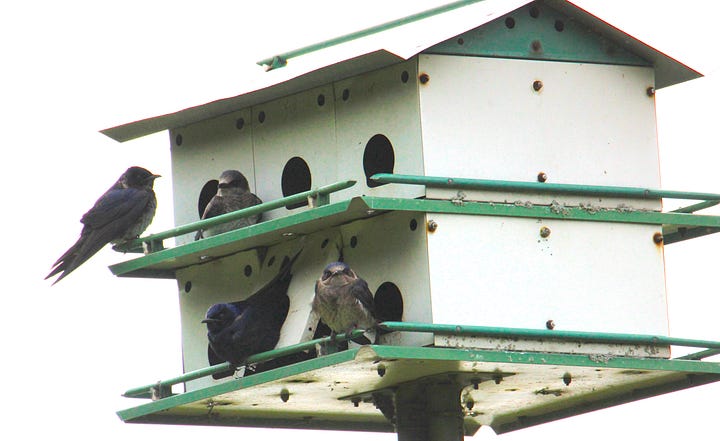
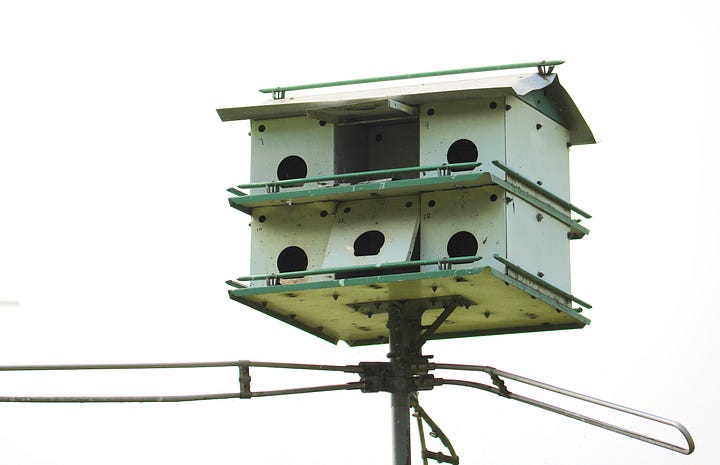
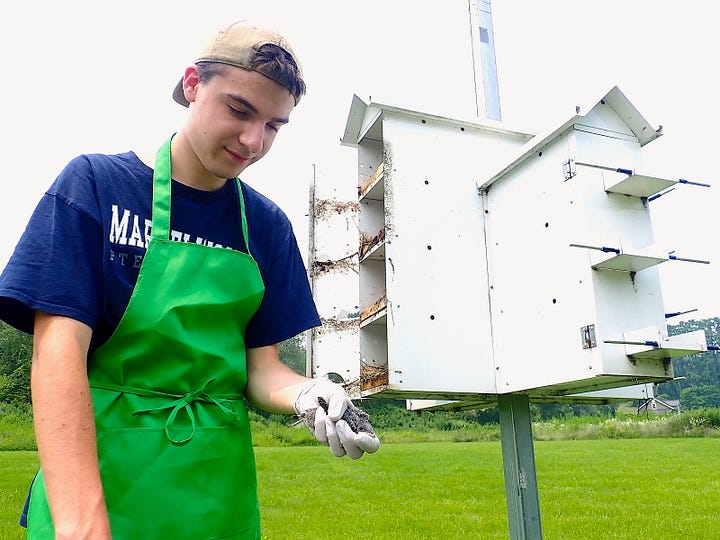
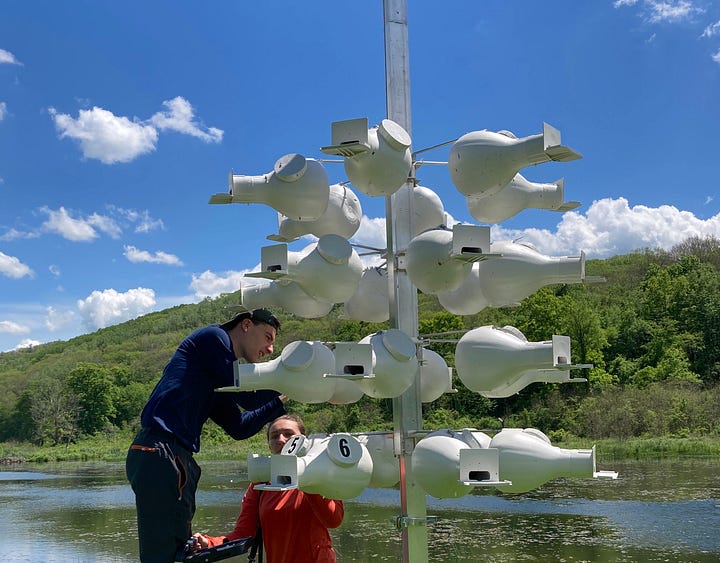
MF: I guess all these things you mentioned, the design of the house or the environment, need to be considered when, say, somebody wants to host a colony. And they can get help [to] make that assessment? Because obviously people are not capable of doing that themselves?
LD: Yeah. And I think the best thing is, you know, it varies. We did a study for Texas Tech University where we were looking at temperature and humidity. Ashley was involved in that and trying to determine does there need to be regional locations for housing types. You know, out in Texas and Oklahoma, they're having longer heat waves than we're having. And so the jury's still out on that. But the best thing to do is to look around your area and see what type of housing Purple Martins are using and then try and duplicate that. We have found that they gravitate to the gourds quicker than they do some of the metal housing that's been placed up by others. And that is the best way to do that.
And then in terms of individual people, I don't know if this is one of your questions, but I'll just say this here, I think it sort of fits, is that individuals, they get older. I think the average age now for a Purple Martin host or ambassador is in their mid-60s. And so what happens when they get sick? What happens when physically they can no longer check the houses? There's difficulty recruiting the next generation. And that may be because there's not a lot of education about these birds in certain areas. And so in addition to encouraging individuals, we're also encouraging people to try and team up with local organizations, whether it be nature centers or land trusts, to erect housing. Because that is a more sustainable model. If you have a land trust or a nature center that's going to go on for a while, they may lose a volunteer or caretaker. But they can recruit a new person. Or when they bring new interns in and train them. And so we're trying in each area to have more sustainability by encouraging various organizations to partner with the public or individual landowners. Even if they have their land and conservation easement. So that it is a joint venture. And there's always a sustainable pool of people who are going to be able to care for the martins in the future.
MF: I was curious about that. Because when I was reading the report, sometimes it was mentioned that colonies were abandoned. And I wondered what could have been the reason. So people aging out and no longer taking care of it and all that. I was wondering if it makes sense for private landowners in Hudson Valley who may be interested in doing stuff like this [to become a host of a colony].
But I guess it has to be close to already existing colonies?
LD: Well, that's how we started. And we found in our area, like, most will disperse within like nine or so miles. But the average distance most will disperse is within 37 miles of the natal colony. And I think the site in the Berkshires is between like 30 and 33 miles. I'd have to check that. So that's how, why we were successful. We started with known colonies. We had a colony just down the road here from Marvelwood School. That was where I first saw my first Purple Martin. We improved the house in there. And then they were nesting in broken lights up here at the street lights and broken globes. And so we said, let's add a Purple Martin house here. We took the old house from that side, added it here, and then we attracted martins just within a few weeks of setting that up. And then we improved the housing here. So that is, I think the best way is to reach out where there are known colonies of Purple Martins and look for suitable habitat and organizations. Maybe they could partner together and set up some housing.
MF: So if somebody in, say, Catskill wants to participate, it's not that distance is a problem. It's more about building the support team.
LD: Yes, building a cooperative multi-organization/generations support team is probably the easiest and most sustainable method, but individuals can host colonies too. But our focus has been on the sustainable model — because I had a bout of cancer in 2023 I started to worry about what would happen to all these Purple Martins in the northwest corner? But fortunately, through Marvelwood School's Avian Ambassador community service program and the Kent Land Trust Internship Program we were able to continue our colonies and research. In working with Ashley and her brother over the summer and throughout the year, they and the other students knew what to do when my energy and mobility were limited. So when I was recovering from my chemotherapy, all I had to do was sit down and they occasionally asked me a question. They were able to monitor, put up housing, do nest changes, extract the chicks and help me band birds under my supervision. So if we hadn't had that to fall back on, what would have happened to these Purple Martins?
MF: Right, right. That inter-generational relationship of the people working together was another thing that was really fascinating. So I wanted to ask about the student participants in a little more detail.
LD: Before we do that, I wanted to also say that this started out as a partnership originally between Kent Land Trust, Marvelwood School and the Purple Martin Conservation Association to try and restore inland populations here. And it's always been a partnership. And then we added the partnership with Connecticut Department of Energy Environmental Protection, by helping them with their natal dispersal banding research. So our model has always been a community partnership. Recently we have added new organizations to the partnership such as Sharon Audubon. We've just emphasized training and educating more people now in the event something happens.
AW: The students at Marvelwood, we've helped to monitor and care for the birds. During the school year, we would take down, clean and set up the gourds for the next summer of banding. When we had GPS tags on the birds, we would try and go out and we would take pictures to try and locate those birds to retrieve the GPS tag.
We've also given presentations during the winter when martins are not around so that we could educate others about martins, like the Sharon Audubon or just the local community martin's with the goal of getting more people and organizations involved.
LD: And I think another big thing is we received a grant from the Jenium Foundation to increase housing at some of our existing colonies or to establish new colonies in the area. These community partnerships which recently expanded to include Audubon Sharon is helping to increase populations of martins. We also received a grant to put housing up at the Housatonic Valley Regional High School. Adding local school students into the resource pool has been helpful to land trusts and nature organizations. So these kids actually assemble the houses as well, dig the holes and put them up, because we know each individual organization doesn't have a plethora of resources to use to do this. So by having students from Marvelwood do this as part of their community service project throughout the year and using local students and interns to help monitor the housing during the summer makes a big difference in the success of this project.

MF: What is the nest made of, by the way?
AW: Well, inside the gourd, normally we'll start it off with putting in some, like, dry pine needles. But then the birds will bring in, like, sticks and leaves, hay and grass. They make a shallow-cuplike nest and some will build a wall of mud in front of the nest. And once they start bringing in green leaves, that's when we know that they're gonna start laying eggs. We don't really know the purpose of the leaves yet, but…
LD: There's two theories. You know, some think it helps with parasites, some think it helps with humidity. I would probably go with the humidity route. Because when you're incubating eggs, you have to keep the humidity at a certain level to help with hatching, to go from there.
MF: And what about the outer structure? That people-made part.
AW: That's just plastic? I'm not sure.
LD: Yeah, it resembles the natural gourds. You know, there are many people who host Purple Martins who grow their own gourds. And then they will adapt them with tunnels and lids so they can check them. But these are just plastic gourds that sort of mimic the older gourds. And one of the problems with these older housings, older houses that have been abandoned that you see is the compartments are too small. They're like four by five inches. And it's too small for, like, four to five chicks and the parents. Some people who still insist upon using the older style metal housing, they're being encouraged to remodel and enlarge the cavities so that they offer only six rather than 12 cavity openings. The bigger compartments enhance nesting success.
MF: And somebody's manufacturing this, the plastic version of it?
LD: Yeah. There's various manufactures and organizations making and selling gourds. Troyer gourds have been proved to be very successful in attracting martins in our region. Excluder Gourd are another extremely successful gourd style. There's different companies that manufacture gourds. Some are better than others, but we are just commenting on the ones we know have been successful in our area.
MF: Okay. I also saw the photos of students banding so they really get to have the firsthand experience of the bird.
AW: Yeah, I actually, when I was, I think, just a freshman, I got to put my first band on a bird, which was super cool because I was really hoping I could. And now I get to put the color bands on sometimes the USGS band. But it's just helpful to… because we get so many birds, it's just helpful to like, move the line along.
MF: So it's that busy.
LD: Yeah, it's that busy. And so actually the bird near Lenox (Stockbridge) that was located and photographed had a yellowish gold metal band, which is an alphanumeric band with an alpha numeric code and it had the blue plastic band on it. We knew we had banded at Miles Wildlife Sanctuary. However Ben Nickley was able to get a number off the color band in his photo and we knew exactly when it was banded and by who. Ashley helped to band that bird two years ago. I put on the USGS band and she put on the color band. And is that rewarding, Ashley?
AW: Definitely. I was thinking it was almost like sending your kid off to college. It's not that sad, but it's kind of what it feels like because then you get to see them like kind of grow up in a sense and thrive and break records of breeding. Yeah, it's just very fulfilling.
LD: Yeah. Because only about 25% of the nestlings actually will even survive their first year because there's so many perils on the migratory journey. Do the parents abandon them early if they've nested late? Predators, whatever it may be. So that is one reason why we've tried to have colonies that are sort of medium sized and have several smaller colonies sort of dabbled around the northwest corner. Because the more young we can get to survive, the better off it's going to be for the population.
MF: I can't quite picture lots of students [there at a banding site]. But they have a lot of things to do at the site.
AW: Yeah, A lot of them will age the birds and take data while we band them. And they can also, if we have groups of people, they'll take the birds and show them how to age. Then we can also get other people involved in that.
LD: And then they shuttle the birds back and forth. They put them, you know, we number the bucket with the gourd number and the gourd rack and we band the birds. And then we have people who shuttle them and put them back and bring us new birds. Trying to make it as efficient as possible.
MF: That's quite a big operation. So when you say age the bird, you mean, checking the feathers and all that?
AW: Yeah. We see how much the feather shafts have come out of the bird. We check the coloration of the bird too, the size of the bird. We have a chart that will look for nestlings. Adults are different, but for nestlings, that's what we do.
MF: And so students, do they get, first lecture in the classroom and then hit the field, or how does that work? They get trained, right?
LD: They get trained. Because when we're managing the colonies and doing nest checks, we have when the young first hatch, we have to age the bird too. And so we do this in small steps throughout. And Ashley is probably the only student I've, you know, in terms of putting the metal color bands on, that I really allow to do that. The plastic bands are a little easier to put on. You just slide them on with this spatula, this little metal spatula, and you just snap them shut. But the metal banding or the USGS banding requires a few more skills to make sure you don't injure the birds. So we don't let many students do that part of it.
MF: Yeah, that handy skill is separate from your love for birds. You either can do it or not.
LD: You can do it or you can't. And the other thing, it's not just Marvelwood. A lot of times it's Marvelwood Students who become interns for the Kent Land Trust who are then training interns from Audubon Sharon, interns from other land trusts in the area with their internship program. We've been Bend of the River Audubon with, they have something called the Junior Forest technicians, and they've been coming out now, I think this is the fifth or sixth year. They have a crew about 12 that will come and help us at Marvelwood and to band and the design to expose kids to different career options and work that goes in to conserve a species.
MF: I'm really grateful for of any of these youth programs because the impact that it would have on people's lives, you know, as they become an adult [is huge]. Having this firsthand, really close experience with the birds. This is something I thought about Ben Nickley’s [American] Kestrel nest box project too, that each collaborator of his project, they get to have an event and kids come and they get to see the chicks. That's a really big impact. And just seeing young people so interested and focused about wildlife or any of their interests — I'm a member of the Alan Devoe Bird Club, and the club had a walk with New York State Young Birders Club. They [the young birders] came with a big camera and everything, and they're really engaged. Who said these kids these days don't have a long attention span? These kids can focus for three hours. That really gives me a hope about future.
LD: It sure does. And I think the more you can expose them and give them hands on experience, the more you're going to reel them in. And it's not just kids. When we've done programs for adults, they've now wanted to become volunteers. And we have one member of the Kent community who is now monitoring one of her colonies on her own. Just mild input from us. So it frees us up to do other things. And the way I try and let schools and conservation organizations and land trusts know is that Purple Martins are an easy species to study. They're an easy species to monitor if you've got all the right setup. But they're almost like a gateway species into conservation because people who can work with Purple Martins and work to maintain their populations in the state or increase them, they're going to be more likely to engage in other conservation projects or they're going to be more likely to contribute to say funding to help various organizations to do the conservation work or to fund internships.
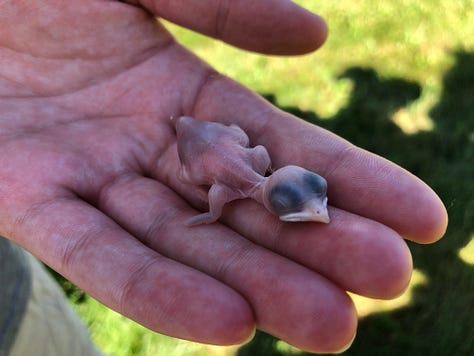


MF: I think that's a good place to ask about the community support since we touched on that topic a little bit. So what can people do? How can the community support the work you do and the conservation of Purple Martin?
AW: The smallest thing is donations, that would be the smallest thing. Education, like giving presentations. And if we give a presentation to someone, they can go out and educate the next group of people. So it's just like a little line of people there.
LD: And if I could interject there, we also have some stock presentations that are prepared that will be able to be accessed later this year from the Kent Land Trust website. So if people want to take our presentation and adapt it to their area, they can do that because that's been a big barrier in the past is conveying the right information and having ready made presentations to help go into local schools. So people who are retired, they could even go into local schools and give these presentations to educate the community.
MF: If somebody wants to do it, can [they] practice and you give [them] a feedback and all that? You get a little bit of training?
LD: Absolutely.
AW: Another way is, you can become a member of the Purple Martin Conservation Association just to learn a little more about the research and just be able to support them. You can host your own colony like we talked about before. You can volunteer like we have that new volunteer in Kent. We could always use more. Protecting inland wetlands and plant native species. There's a lot of invasive species that we need to help get rid of. But planting native species is a good way to protect them.
LD: Because it provides food sources. And protecting inland wetlands provides food sources for martins and other birds as well.
AW: Yeah, there's many ways to help these martins.
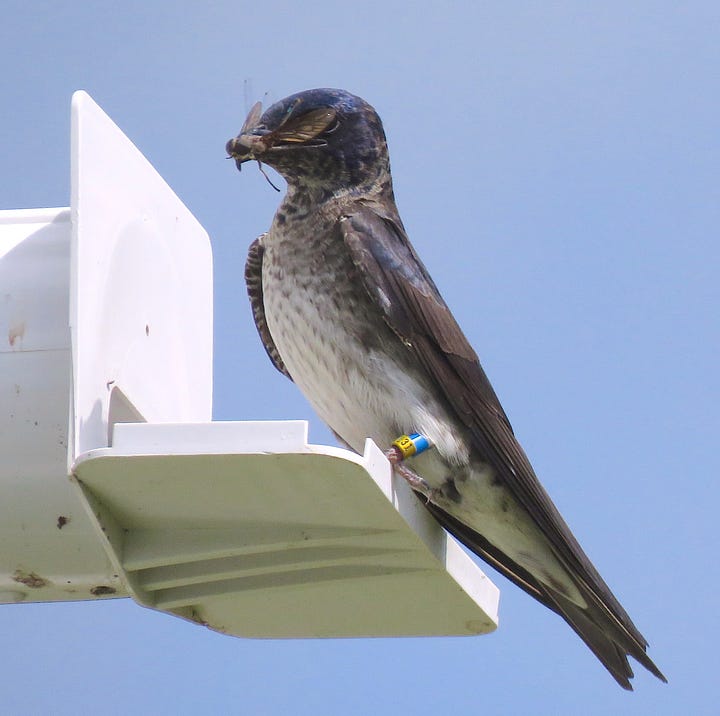

LD: And then another way would be, if you're into photography and you're going out and looking at different colonies, it's been really helpful to get pictures from the community, either on eBird or finding out directly who bands in the state. And sending us photos of color banded birds. It helps us to understand where they're dispersing to, how far they're dispersing to, and where new areas to target, like the Berkshires now near Lenox.
You know, if you find suitable habitat, putting up new housing might start to attract even more Purple Martins to the area. And I know we gave Ben and his crew our old Texas Tech setup with some gourds so that the martins that are breeding in this new area in Lenox now, when the young fledge or even the adults, they can check out this gourd rack, become familiar with it, and they're more likely to come back to the area to breed the following year or go to an area near that. The young, they'll return to their natal colony, but they usually get pushed out. Only about 10% of the young birds will be able to breed at the natal colony. They usually get pushed out and dispersed and they're looking for housing in other areas. And once the young fledge from the nest, they're like, are there any potential martin hotels in the area where I could come back next year? But if a bird has been successful breeding, then the adults will come back to the same area to breed. And you can even introduce improved housing, which is what we did over time to enhance their success.
MF: Right. When you see a photograph, you can tell where they come from, from the color of the band.
LD: And if you get the number, we can tell you the exact year that they were banded.
MF: Oh, that'd be exciting. So how can people — you say volunteer and all that — how can people get in touch with you?
LD: The best way would be through my email address. It's laurie.doss@marvelwood.org.
MF: So if they want to join as a volunteer, host of the colony, they can just email you and find out more information. Okay, that's great. Thank you very much.
LD: You're most welcome.
Online-Only Special Content
Laurie demonstrates how to determine the age of a baby martin
Laurie and Ashley check on the Purple Martin colony at the Marvelwood School
PMCA Purple Martin NestCam
https://www.youtube.com/watch?v=gof_JlLA4IA
Bird-inspired Music of the Month
A bird-inspired song recorded in March 1903 on an Edison gold-molded cylinder, swallow songs by Vashti Bunyan and Michael Hurley from the '70s, and a field recording of シマフクロウ Shima-fukurou (Blakiston's Fish Owl) by Yoichi Kamimura from his brandnew release ryūhyō (forms of minutiae, 2025).


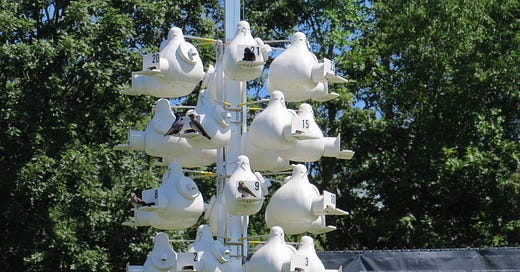





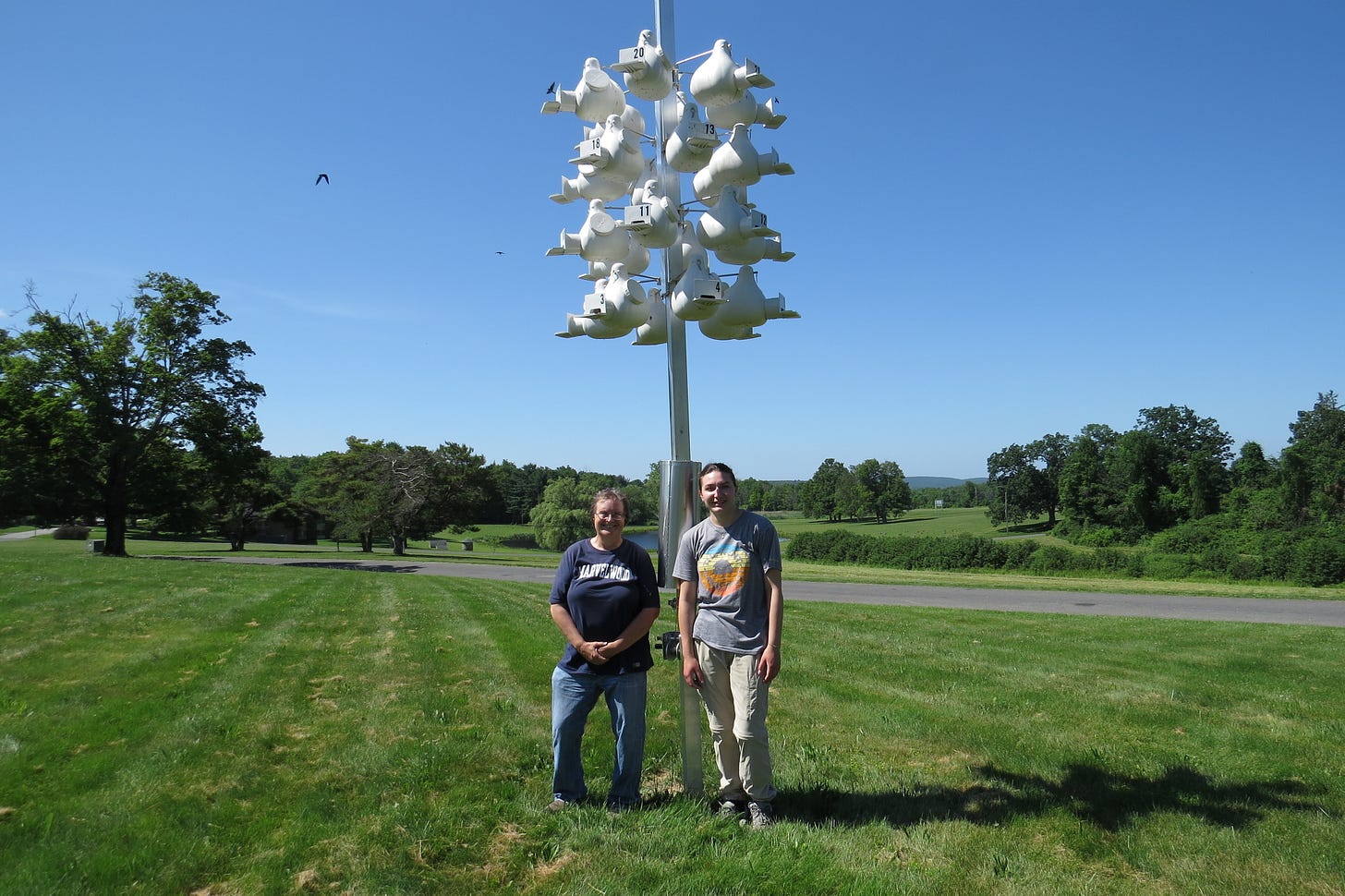
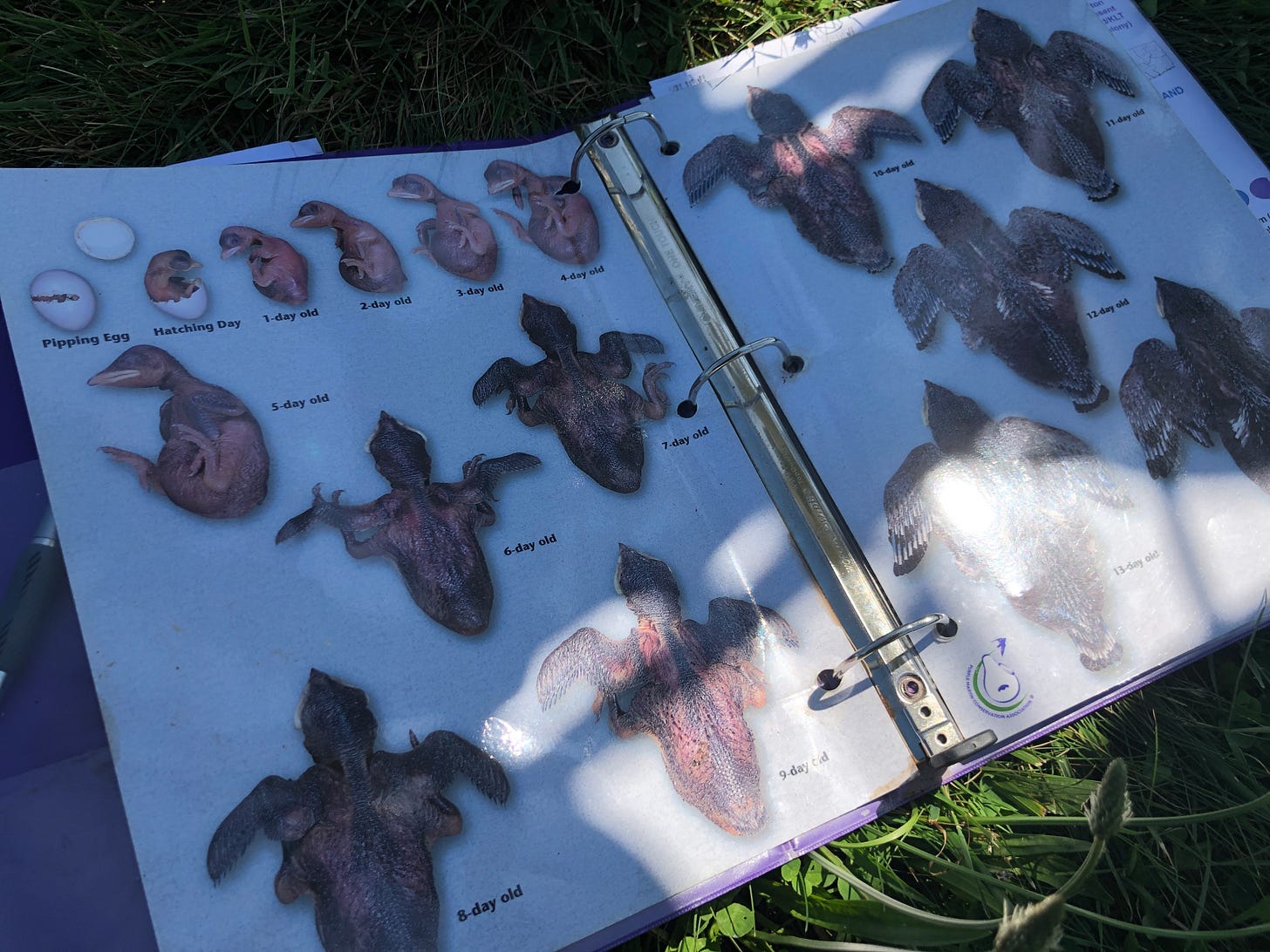






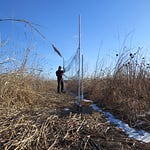


Share this post